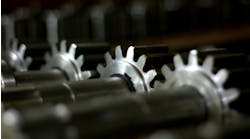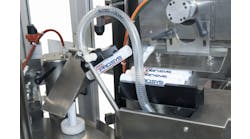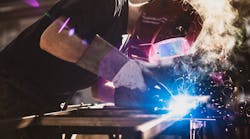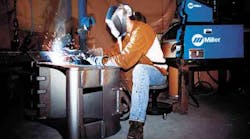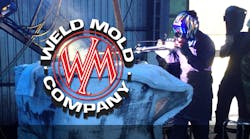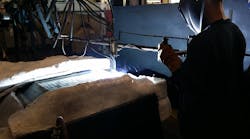In nearly 25 years as a forging tool and die welder, I’ve had some really good days. The die is hot enough, the radio is playing loud, and the boss is on vacation. All I have to do is keep the wire (FCAW in most cases) running at 20 pounds an hour. Easy, right? Few things can turn a good day into a bad day faster than feeding problems for a welder running wire.
In my experience, the feeder itself is usually not the problem. The problem starts at the drive rolls and can run all the way to the tip. It starts as what is described as “chatter” or “stutter”: the wire refuses to feed smoothly, and the welder can feel the resistance in the handgun.
MIG guns come in many different sizes and run a variety of diameters and types of wire. From mild steel to aluminum, tool steel to copper-based alloys, MIG welders today are used in every industrial sector—including essential die and tool repair at forging shops everywhere. It doesn’t matter where it's found—whether in the robotics-rich environment of the automotive plant or in the neighbors’ garage—the one thing they all have in common is the drive rolls, cable, and torch that deliver the filler metal and shielding gas (or not) to the area needing a weld.
Whether you are running a solid or flux-cored wire, shielded or open arc or even sub-arc, wire-feeding problems are encountered in all of these types of welding. You’ve run literally miles of wire through your gun flawlessly with just regular tip changes, and now it decides to act up.
Here are five common problems with MIG equipment, along with some reliable solutions that I have learned, if conducted regularly, will keep your good day from going bad.
1. Drive Rolls Are Not Cleaned or Adjusted Properly
The drive roll groove (and knurls on rolls so configured) can become packed with the drawing compound (used during wire manufacturing to reduce the size of nearly all the solid or flux-cored wire used in the MIG applications), industrial grit from grinding, and smoke from welding. This can affect the tensioning and grip on the wire. Smooth rolls used for solid wire are less affected than knurled rolls used for FCAW wires.
The Solution
Periodically remove the drive rolls and clean them with a wire brush to eliminate the build-up of drawing compound, dust, and dirt that would affect the pressure and grip the rolls would have on the wire. At the same time, inspect the drive rolls for wear. They will wear out, especially if knurled.
2. Drive Roll Pressure Is Too High
It’s common when a feeding problem arises, to tighten the drive rolls in order to grip the wire better to overcome the problem. This is especially true when using knurled rolls for flux-cored wire. Because of its construction, flux-cored wire is easy to reshape from round to oval; with drive roll pressure and when using knurled rolls the wire develops “teeth". These teeth will start to wear the liner, guides, and tip like a saw. Solid wire, when used with knurled drive rolls, will not change shape like flux-cored wire, but will develop the “teeth" and similar wear.
The Solution
Periodically, before feeding the wire through the cable/hose assembly, use an air nozzle and shop air pressure to blow out the liner, first from the torch end and then, if convenient, from the feeder end. The amount of small debris blown out of the liner will surprise you. Shavings from the wear and wire have a tendency to "pack up” the liner at non-contact points and junctions (diffuser/tip.) This will cause the wire to chatter or stop feeding altogether. It will also wear out the liner more quickly.
3. Worn Spring Liner
The spring liner used for almost all cable/hose assemblies is removable and replaceable. Almost all spring liners have at least two bends that are constant. One coming out of the feeder, the other in the torch neck. The wire rubs the same spot and wears a groove in the liner. This acts as a high-friction area as the groove deepens, and the more bends that are permanent, the more it increases the drag on the wire causing it to “birdnest” at the torch inlet or stop feeding altogether.
This is also one cause of the chatter that frustrates welders.
The Solution
Occasionally index, remove, and inspect the liner. A kink in the liner will cause a feeding problem. Blow out the liner guide, turn the liner 90 to 180 degrees and reinstall it. (You did index it before you pulled it out, didn’t you?) This will present a fresh area in the liner to the wear of the moving wire. Eventually, you'll need to replace the liner, but doing this can extend the service life by three or four times what it normally would be.
4. Diffuser/Tip Problems
The most commonly replaced item in a torch assembly is the tip. Because the tip is at the business end of the torch, it receives the lion’s share of the abuse from the heat, spatter, and the operator.
The Solution
Aside from normal wear that results in the need for replacement, the tip is rarely the cause of feeding problems. But, it does show the results of the problem. If the tip has been replaced and feeding problems persist, then there is almost a guarantee that the problem has developed in one of the previously discussed areas.
5. Check Your Ground!
A bad ground can present itself as a stutter and cause the wire to perform as if it needs a voltage or speed adjustment. A lack of shielding gas coverage, liner or tip grab, or base metal contamination, will cause porosity.
The Solution
Make sure to occasionally check the ground at the power source, wire feeder, and work clamp. A bad ground can destroy a tip with burn-back and spatter.
One of the easiest ways to maintain good feeding characteristics, if everything else is right, is to use commonly available wire lube and cleaner, good for MIG and FCAW. Another good idea for preserving the consumables (nozzle and tip) is nozzle dip. These products won’t correct for drive rolls issues, worn liners or weak grounds, but when used according to the manufacturer’s recommendations and the above-mentioned tips, they will promote much longer component life, fewer feeding problems, and many more good days than bad ones.
